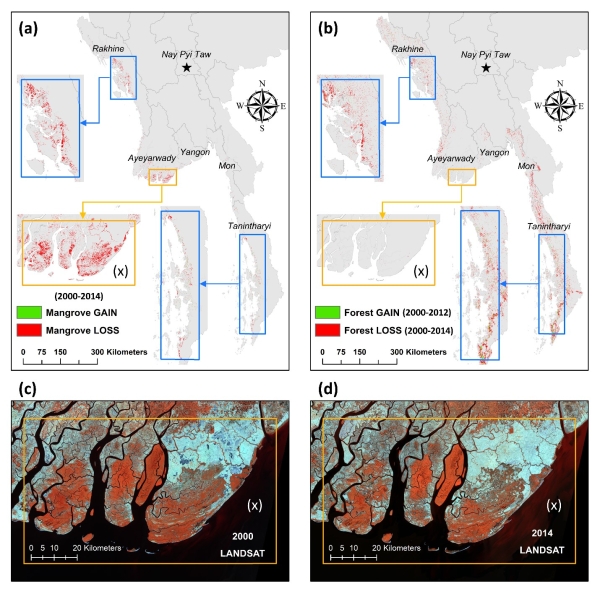論文情報
著者:Ronald C. Estoque, Soe W. Myint, Chuyuan Wang, Asif Ishtiaque, Toe T. Aung, Lucy Emerton, Makoto Ooba, Yasuaki Hijioka, Myat S. Mon, Zhe Wang, and Chao Fan
発表年:2018
掲載雑誌:Global Change Biology, https://doi.org/10.1111/gcb.14409
論文へのリンク(英文のみ)
キーワード
Deforestation; Ecosystem services; Landsat; Mangrove; Moderate Resolution Imaging Spectroradiometer; Myanmar; Remote sensing
概要
Myanmar is one of the mangrove‐richest countries in the world, providing valuable ecosystem services to people. However, due to deforestation driven primarily by agricultural expansion, Myanmar's mangrove forest cover has declined dramatically over the past few decades, while what remains is still under pressure. To support management planning, accurate quantification of mangrove forest cover changes on a national scale is needed. In this study, we quantified Myanmar's mangrove forest cover changes between 2000 and 2014 using remotely sensed data, examined the environmental impacts of such changes, and estimated the changes in the economic values of mangrove ecosystem services in the country. Results indicate that Myanmar had a net mangrove loss of 191,122 ha over the study period. Since 2000, Myanmar has been losing mangrove forest cover at an alarming rate of 14,619 ha/year (2.2%/year). The loss was predominant in Rakhine and Ayeyarwady. The observed mangrove forest cover loss has resulted in decreased evapotranspiration, carbon stock, and tree cover percentage. Due to deforestation, Myanmar also suffered a net loss of 2,397 million US$/year in its mangrove ecosystem service value (i.e. 28.7% decrease from 2000), in which maintenance of fisheries nursery populations and habitat and coastal protection were among those services that were greatly affected. We suggest that intensive reforestation and mangrove protection programs be implemented immediately. Agroforestry and community forestry programs are encouraged in areas that are under immense pressure from paddy field expansion, fuelwood extraction, charcoal production, and fish and shrimp farming activities. Potential alternative sustainable solutions should include intensive government-led private forest plantations or community-owned forest plantations to be developed with care by local farmers, nongovernmental organizations, and business owners.





